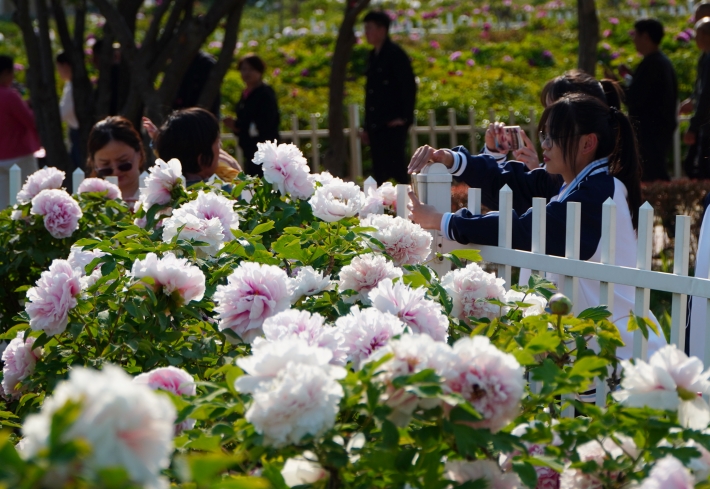|
||||||||||
| Home Top News Economy/Tech Culture/Sports China in Foreign Eyes Green Development Videos Intangible Cultural Heritages |
|
||||||||||
| Home Top News Economy/Tech Culture/Sports China in Foreign Eyes Green Development Videos Intangible Cultural Heritages |
| ChinAfrica |
| A Flowering Future |
| The peony has become a cultural and economic powerhouse in Heze |
| By Li Yin and Donatien Niyonzima | VOL. 17 May 2025 ·2025-05-07 |

Visitors admire blooming peonies at Caozhou Peony Garden in Heze City, Shandong Province, on 7 April 2023 (XINHUA)
The peony, revered as the “king of flowers” in China, has long transcended its botanical identity to become a cultural icon deeply rooted in the Yellow River basin. In the fertile plains of the Yellow River, Heze City in Shandong Province has long held a special connection with the peony. With a 1,500-year history of peony cultivation, the city has earned its title as the “Peony Capital of the World.”
Heze’s peony culture reflects China’s enduring relationship with nature and represents the intersection of ancient heritage and modern innovation, providing a blueprint for cultural preservation and global cooperation.
In addition to 1,308 varieties of peonies with nine colour categories and 10 flower shapes, the fertile soils of the Yellow River have contributed to Chinese civilisation’s spiritual essence as well. As a cultural symbol of China, the peony has long flourished beyond its homeland through international trade and has gained worldwide recognition through trade and cultural exchange. It provides the international audience with a vivid lens to perceive Chinese culture and grasp the essence of Chinese civilisation.
The 80-hectare Caozhou Peony Garden in Heze is home to 800,000 plants, where visitors from all over the world can admire the artistry of nature. But the story of the peony in Heze goes far beyond flowers and gardens - it is a story of change, in which a single flower drives economic vitality, technological ingenuity and cross-cultural exchange.
Unlimited potential
Beyond its aesthetic splendour, the peony has become an economic powerhouse in recent years. By 2024, Heze’s peony industry generated an annual turnover of 13 billion yuan ($1.78 billion) and supported 500,000 jobs through 120 specialised companies exporting to more than 30 countries. These impressive figures show how cultural symbols can promote inclusive, sustainable growth.
The peony industry perfectly reflects Heze’s commitment to sustainable development. Local businesses like Yao and Shun Peony Biotechnology have transformed the flower’s value chain by using advanced technology to maximise the use of every part of the plant. In a modern industrial area next to fragrant fields, roots are turned into traditional medicines, seeds produce high-quality cooking oil, and the delicate petals become edible art. Even the pollen finds a role, brewed into health teas, while essential oils from petals enhance skincare products.
Peony pastries, known for their vibrant colours and complex designs, have become popular souvenirs. “These pastries were specially upgraded for the 2025 World Peony Conference,” explained Liu Yu, sales manager at Shandong Daoxiangcun Food, as she presented samples. “Each pastry reflects a stage of the flower’s life cycle and its nine colour categories. Using locally sourced ingredients also supports farmers. Each bite tells the story of Heze’s agricultural heritage,” Liu shared with ChinAfrica.
New model for tourism
As the economic significance of peonies grows, Heze has reinvented its cultural tourism. Moving beyond just seasonal “flower-viewing tours,” Heze has developed immersive cultural experiences. Visitors can explore peony-themed museums that trace the flower’s cultural journey, enjoy art exhibitions that blend classical and modern themes, and attend live performances celebrating the region’s heritage.
The nearby hanfu industry focuses on traditional Chinese clothing, which enhances this cultural revival. Cao County in Heze, a centre of hanfu production, now generates 12 billion yuan ($1.64 billion) annually and holds 50 percent of China’s market share. By incorporating peony designs into these garments, Heze is revitalising timeless traditions, inspiring both young people and tourists.
These initiatives have gained international recognition, with Shahbaz Khan, director of UNESCO’s Regional Office for East Asia, praising Shandong Province and Heze City for promoting the protection and high-quality development of peony culture. “The efforts in building a demonstration zone for environmental protection and sustainable development is an inspiring example of how cultural heritage can be integrated with modern initiatives to create harmonious and sustainable future,” he remarked in a video speech during the 2025 Heze Peony International Communication Forum on April 10.
The event gathered diplomats and scholars from over 30 countries, encouraging cross-cultural dialogue through the lens of Yellow River civilisation and peony culture. Du Zhanyuan, president of China International Communications Group, highlighted the importance of learning from diverse civilisations to foster harmonious coexistence.
Global reach
The peony’s journey from imperial gardens to global markets mirrors China’s transformation. In Heze, where the peony industry continues to flourish, locals are weaving new chapters into this ancient narrative. Once praised by Tang Dynasty poets for its fleeting beauty, the peony now stands as a symbol of lasting dialogue - bridging the past with the future, marrying local craftsmanship to global commerce, and balancing ecological sustainability with industrial ambition.
Today, Heze’s peony products are found on shelves from Berlin to Tokyo - not merely as goods, but also as symbols of a civilisation that respects its roots while embracing shared growth. The beauty of the flower transcends borders. In Heze, the peony is the heritage that flourishes not through isolation, but through reinvention, connection, and collective progress.
| About Us | Contact Us | Advertise with Us | Subscribe |
| Copyright Beijing Review All rights reserved 京ICP备08005356号-5 京公网安备110102005860号 |